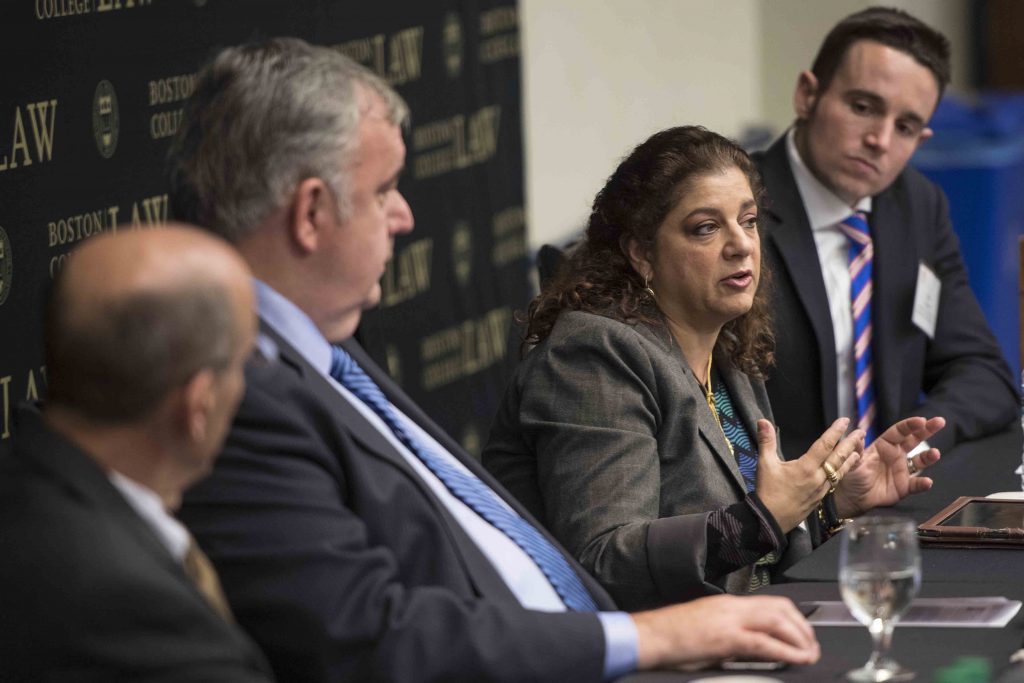“Whoever fights monsters should see to it that in the process he does not become a monster. And if you gaze long enough into an abyss, the abyss will gaze back into you.” This saying, long attributed to philosopher Friedrich Nietzsche, captured the tone for the Rappaport Center for Law and Public Policy’s event “Terrorism: Threats and Responses” that kicked off Alumni Weekend at Boston College Law School (watch video below).
The November 4 panel engaged experts with decades of law-enforcement, anti-terrorism, and academic experience as they fielded questions by panel moderator Peter Krause, a BC political science professor. “None of us are lawyers or have professional legal experience,” he told the audience, “and I think this panel is a great opportunity to demonstrate nonlegal perspectives on the continuing issue of violent extremism and terror, as well as to show what non-lawyers can do to help.”
A central theme of the discussion was the growing challenge of counteracting and identifying homegrown extremism, a change from the counterterrorism of the early 2000s, during which time “the principal threats came from outside the country, from Al Qaeda, and from places like Afghanistan and Iraq where operatives from training camps posed the greatest threats to law enforcement,” said panelist Edward Davis, former Boston police commissioner with over 30 years serving in police departments across Massachusetts. “Nowadays, the challenge isn’t so much preventing foreign extremists from coming into this country as it is identifying and prevent radicalization over digital sources such as social media.”
Referencing what she’s seen while keeping track of extremist social media such as ISIS’ Facebook and Twitter feeds, Mia Bloom, professor of communications at Georgia State and research fellow for the Minerva Research Initiative at the Department of Defense, agreed. “What we’re seeing is a real paradigm shift. Groups like ISIS are focusing on external recruitment and radicalization. Many of their leaders see this method as more effective and economical than building a large infrastructure within the territory they control,” she said.
The panelists, which include Kurt Schwartz ’86, director of the Massachusetts Emergency Management Agency, agreed that the extent of radicals’ outreach to youth in western countries who feel excluded and marginalized might help explain ISIS’ disproportionately large presence when the actual members of the Islamic State could easily fit within a sports stadium.
However, Bloom believes that the emphasis on foreign outreach is causing its own set of issues for the Islamic State. “Foreign fighters are given the first pick of wives, houses, a higher stipend, etcetera, and the widening inequality gap between foreign and local fighters is causing much instability within the movement,” she explained. “And it’s detectable even through social media.”
Identifying the source of a threat is only half the battle. The panelists shared the view that the greatest challenge facing antiextremism and terrorism policymakers is devising effective counteractive strategies that do not further alienate western Muslims and expand the potential recruitment-ready sympathies for the foreign organizations.
“Because organizations like the Islamic State are heavily focusing on exploiting the sense of exclusion many young western Muslim men feel, it is imperative to establish trusting relationships with communities. Every single terrorist plot that has been foiled was done with the help of other local Muslims,” Bloom said, emphasizing that the most effective way to fight threats from homegrown terror is to engage in constructive dialogue between majority and minority communities.
Davis, currently a security consultant, agreed, though he emphasized that some parts of the politically correct culture are stifling antiextremist efforts. “If we’re going to come up with ways to fight something,” he said, “we must be honest about what the threat is and where it comes from.”
He recalled successful efforts during his time in the Lowell and Boston police departments to reach out to Muslim communities. “A mosque is like a small city, there are many opinions in one place, and when law enforcement reaches out and takes the time to listen to all of them, trust usually follows,” he said. “Trust is our most valuable asset in finding, identifying, and preventing more tragedies.”
Pictured, left to right: Kurt Schwartz, Edward Davis, Mia Bloom, Peter Krause. Photograph by Christopher Soldt, MTS, BC


